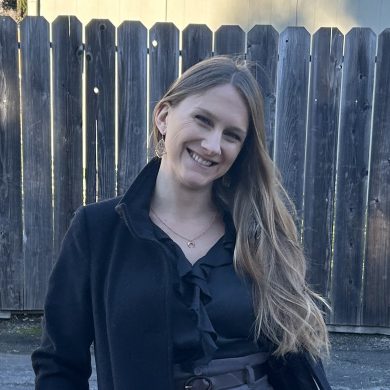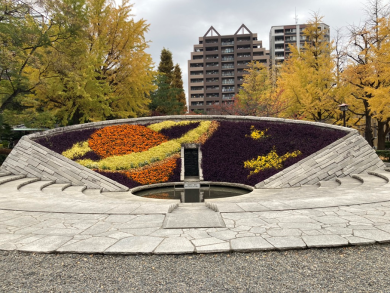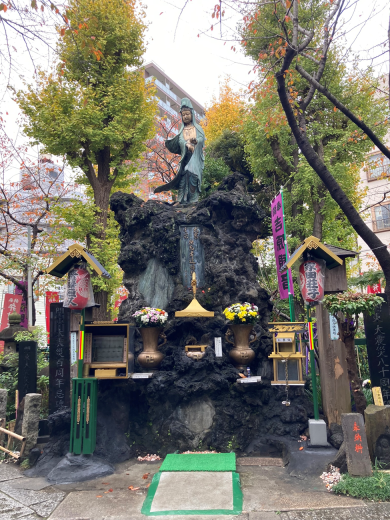Grad Profile: Clara Bergamini
 Clara Bergamini is a PhD candidate in History at UC Santa Cruz. Her dissertation explores the relationship between catastrophe and national identity in Japan. In February, we learned more about Bergamini’s ongoing research. Bergamini was a 2021 NHC Summer Fellow, a 2019-2021 GSS Fellow, and is currently serving as a 2022-2023 SSRC-DPD Fellow. We discussed Bergamini’s interest in catastrophe as a political mobilizer, the importance of site-based research in studying memorialization, and the positive impact of collaborative peer spaces for pedagogical development and mutual support in grad school.
Clara Bergamini is a PhD candidate in History at UC Santa Cruz. Her dissertation explores the relationship between catastrophe and national identity in Japan. In February, we learned more about Bergamini’s ongoing research. Bergamini was a 2021 NHC Summer Fellow, a 2019-2021 GSS Fellow, and is currently serving as a 2022-2023 SSRC-DPD Fellow. We discussed Bergamini’s interest in catastrophe as a political mobilizer, the importance of site-based research in studying memorialization, and the positive impact of collaborative peer spaces for pedagogical development and mutual support in grad school.
Hi Clara! Thanks for chatting with us about your archival work and your ongoing research and writing projects. To begin, could you give us a general synopsis of your dissertation project?

The primary question that I started my dissertation with was: how is the lived experience and memory of catastrophe written into social, political, and physical landscapes that shape people’s lives? My dissertation takes up this question by examining the two most catastrophic disasters, in terms of loss of life and damage, that occurred during Japan’s industrial, imperial, and nation-building endeavors in the late nineteenth and early twentieth centuries: the 1896 Meiji Sanriku earthquake and the 1923 Great Kantō Earthquake. I explore (1) how these two catastrophes informed conceptions of imperial and national identity at the same time that they shaped people’s perception of the world and their place in it; and (2) how the consciousness of inevitable crisis, learned either through personal experience or education, informed and even anticipated Japan’s transition into war in the 1930s and 1940s. To get at these topics I’m moving away from the traditional dissertation model a bit by bringing together Geographic Information System mapping and monograph-style narration to create an interactive website that takes viewers through the socio-political and environmental history of these disasters in visual and written modes.
Your work is interested in exploring the relationship between disaster and nation-building. Why is it important to study the role of crisis in national historical narratives? I’m wondering what insights your work may offer to our contemporary moment, when international crises seem to abound: from COVID-19, to the rise of neo-fascist governments, to climate disasters that span the globe?
One thing that many disaster studies scholars writing in English will tell you is that historically, catastrophe has been understudied as an essential element for understanding long-term social, political, and economic change. Often, things like droughts, famines, earthquakes, and the like have been treated as momentary setbacks in a given society’s march forward through history. We see some of this with COVID-19 as well: the almost constant pleas for things to “go back to normal,” when, as any of us who study large-scale catastrophes know, these moments of crisis often create new “normals,” and always initiate long term changes locally, nationally, and globally.

In Japan’s case, being a disaster resilient country has become a point of national pride: they are an “earthquake nation,” as one scholar has aptly put it. Part of the reason for this is that moments of crisis–whether it be disaster or war–can and has been treated as a moment of opportunity for various political actors to further legitimize their own political positions or destabilize others. For example, when the Kantō earthquake struck Tokyo in 1923, it became an ideal reference point for people to argue that this or that model for the ideal Japanese nation would guarantee that the country would never again suffer such a tragedy. Each year during the disaster’s anniversary, politicians would take the stage to remind the public that to properly memorialize those who lost their lives during the Kantō disaster, they must dedicate themselves to a specific set of national ideals and models of behavior. Similar to what we see in the United States today, Japan in the 1920s after the Kantō earthquake had a very contentious political landscape and the memory and long term effects of the Kantō disaster were used by everyone on the political spectrum to argue for their relative solutions to the nation’s problems. Despite the level of political contention, all of these commentators did at least seem to agree that there was a nation worth forging, they just disagreed on the exact form that nation should take.
Essentially, what we see over and over again is that catastrophe creates an opening for change.
Essentially, what we see over and over again is that catastrophe creates an opening for change: it creates a stage in which people are listening because after a large catastrophe, suddenly people who might have been relatively apolitical before are invested in things that they likely never even thought of in the past: be it construction laws, insurance policies, the number of parks that can be used as fire breaks, or water management issues. Most of us do not think about these things in our daily lives, but as climate change continues to serve us bigger and more frequent disasters, I imagine that we will see increasing political engagement from the public and I think the most important thing to do in anticipation of that is to be aware of how easily these crisis can be taken advantage of and to be ready with legible and human-centered solutions to our growing list of environmental challenges.
You spent time this summer and fall quarter doing research in Japan at the Diet Library, Tokyo Metropolitan library, and Tohoku University’s International Research Institute of Disaster Science,and in the US at Stanford’s East Asia library and Duke University’s archives. I imagine this archival research revealed a host of fascinating documents, histories, and stories, but was there a specific text or a specific moment that stands out to you from your research–a moment of surprise, shock, awe, or understanding you’d like to share with us?
What I discovered during my trip is how essential it is to spend time in the places we study–to actually physically occupy the spaces where past events occurred and examine the ways in which the memory of past events and processes have carved themselves into the physical landscape.
After years of being forced to do digital archival work while Japan was closed to international travel, I had actually been quite successful in finding a wealth of documents that had been digitized. There was also of course the fact that finding historical documents on the imperial period in Japan tends to be challenging because many documents were destroyed by the U.S. during the firebombing of Tokyo in 1945 or by the Japanese government after they surrendered. Still, I had imagined that once I actually went to the physical archives in Japan I would find a wealth of information that had been entirely inaccessible in online archives. However, once I actually started looking at the documents available in the physical archives, I did not find anything that was particularly groundbreaking. I often found myself planning for whole days in the archives only to find myself done going through what was available in a few hours. So, I decided to change gears and spent a great deal of my trip in Japan visiting memorial sites for the Kantō earthquake and the 1896 and 1933 Sanriku earthquakes up in the Tohoku region. To my surprise these visits were actually quite fruitful in providing insights into the lasting legacy of these catastrophes. For one, every single Kantō earthquake memorial I visited (over seven throughout Tokyo) had fresh flowers set out at the sites despite the fact that the Kantō earthquake happened nearly 100 years ago. In the Tohoku area you have a bit of a different situation, since many of the memorial sites for the 1896 and 1933 earthquakes coincide with newly constructed memorial sites for the 2011 triple disaster that hit around the same region. Despite the differences between memorials in the Tokyo and Tohoku areas, what I discovered during my trip is how essential it is to spend time in the places we study–to actually physically occupy the spaces where past events occurred and examine the ways in which the memory of past events and processes have carved themselves into the physical landscape. If I had spent my entire trip sat in an archive I would not have been able to fully appreciate the extent to which the disasters I research maintain such a presence in people’s everyday lives.
While your research comprises official documentation and field site visits, you have also shared that you intend to prioritize personal accounts and biographies. Why is it so important to focus on these texts? What can historians learn from personal documents that is especially instructive?
I was initially trained as an anthropologist as an undergraduate, so the idea of constructing historical narratives based solely on government documents and field site visits always seemed a bit odd to me. I suppose that personal accounts and biographies feel like the closest thing I have to ethnographic fieldwork that prioritize a collection of individual voices. I will readily admit that finding personal accounts and biographies has been a challenge, but I do not feel that I should be able to speak with any authority about social and political change by using solely news and government documents.
How has the SSRC DPD program helped you in your research and writing process?
I think the most helpful thing about the SSRC DPD program was that it really forced me to repeatedly rethink and interrogate my research goals and intended narrative for my dissertation. Of course the program helped me put together a huge amount of content that could be used to apply for funding, but the first part of the program lined up with the development of my dissertation prospectus and gave a space in which I could discuss my dissertation plans with people outside of my field.
You received THI support to attend the 2021 National Humanities Center Summer Residency on “Meaningful Teaching and Learning in the Humanities Classroom.” Can you share something from this experience that has influenced your pedagogical values or approach?
Equitable teaching requires that I continually seek to interrogate and improve my own pedagogical practices through collaborative learning with other educators.
While it was all on Zoom, the Residency program was a lot of fun and I am still using a lot of the syllabi building tools and language that I developed in collaboration with others during that summer. I did NHC’s residency not long after going through CITL’s Teaching For Equity certification program, so a lot of what I took away from the residency program built off of what I learned from CITL. What was special about both programs is that it gave me (and others) an opportunity to really interrogate and collaboratively discuss our approach to syllabi creation, in-class discussions, and teaching in general. I think that a lot of professors are a bit uncomfortable with opening up their classrooms to scrutiny from their colleagues and and teaching and pedagogical practice on the university level is frequently done in isolation. There is a lot of strength in the freedom and independence that university system’s grant professors in the classroom, but I think it is equally important that we open ourselves up to spaces where our initial approaches to pedagogy and classroom management might be questioned or guided through discussion with other educators. So I suppose the biggest impact these programs had was just to remind me that equitable teaching requires that I continually seek to interrogate and improve my own pedagogical practices through collaborative learning with other educators.
In 2019-2021, you were a Graduate Student Success Fellow. Why is it important to provide humanities graduate students with community and mentorship?
Being in a room with other new graduate students who were sharing similar struggles to my own helped me feel less isolated during a time in my graduate career that I was struggling with imposter syndrome.
I don’t think that a lot of people who come into graduate school know what to expect: what the advisor/advisee relationship should look like, how to interact with instructors of record as a TA, how to approach graduate seminars, and more generally just how to navigate your position as a graduate student who is simultaneously a student, a teacher, and a colleague to other academics within a university. It is an odd position to be in and it can be challenging to know where you stand in relation to your advisors, professors, and students. The Graduate Student Success Fellows program involved a number of workshops that provided a space where newer graduate students like myself could learn from faculty and senior graduate students about different methods and approaches to navigating professional relationships and juggling the work we have to do. On top of the kind of advisory guidance these programs provide, being in a room with other new graduate students who were sharing similar struggles to my own helped me feel less isolated during a time in my graduate career that I was struggling with imposter syndrome.
Banner Photo: This photo features Memorial Hall at Yokoamichō Park, which was originally built in 1930 to memorialize those lost in the 1923 Kantō earthquake, thousands of whom died in this very spot where many had gathered in a small open field to try and escape the firestorm sweeping through the city. Those peoples’ remains are now enshrined in the tower that you can see peaking out from behind the memorial hall.
